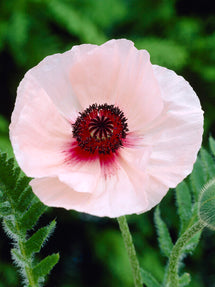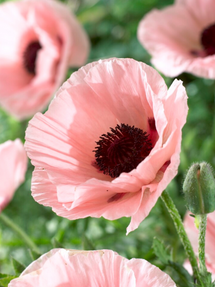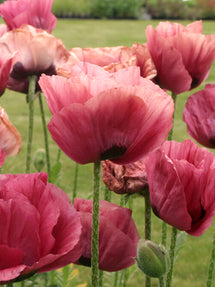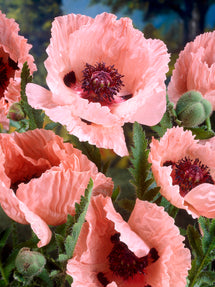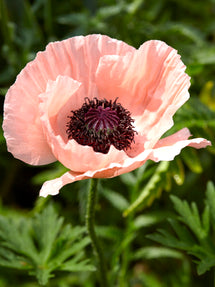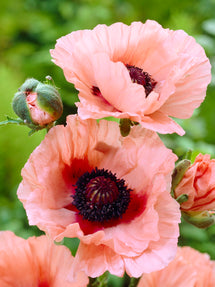Papaver (Oriental Poppy)
Enrich Your Garden With The Beautiful Oriental Poppy
The Oriental Poppy, also known as Papaver Orientale or Asian Poppy, is a striking addition to any garden. Its showy, large Poppy flowers make it an eye-catching showstopper. If you want to make a bold and beautiful statement in your garden, DutchGrown’s Oriental Poppy bare roots are an excellent choice. Our carefully selected varieties are suitable for various gardens and will grow in full sun or partial shade.
Explore our Poppy collection now and add a splash of colour to your garden, year after year.
Showing 1 - 6 in 6 items
Oriental Poppy Plants Are Elegant Showstoppers For Every Garden
Native to Central Asia (northeastern Turkey and northern Iran), Papaver Orientale is a masterpiece of nature. Oriental Poppies bloom in late spring to early summer, gracing gardens with bold, papery petals. They are deer- and rabbit-resistant, making them a low-maintenance favourite, while also attracting butterflies.
This perennial beauty is celebrated for its bold elegance, thanks to its silky, delicate petals and the airy texture of its grey-green foliage. Whether you want to create a colourful statement or a softer, more romantic garden theme, the Oriental Poppy blends effortlessly into various landscapes. It's perfectly suited for cottage gardens and wildlife-friendly spaces, and also makes a striking addition to cut flower arrangements.
Oriental Poppies are prized not only for their stunning appearance, but also for their remarkable resilience. With the right care, they thrive across various climates and adapt well to different garden conditions, making them beginner-friendly plants. Once established, Papaver Orientale will return yearly, gracing your garden with timeless elegance and vivid beauty. It's a plant that rewards your investment, offering lasting visual impact with minimal maintenance.
From Pink To Red Oriental Poppy Flowers: Explore The Vibrant Colours
One of the most captivating qualities of the Papaver Orientale is its range of colours. From bold reds to delicate pinks, these flowers come in various colours to complement any garden. Let’s explore some of the most beautiful Oriental Poppy plants with an aesthetic value:
- Red Poppy plants, such as ‘Beauty of Livermere’, bring a sense of boldness and energy to any garden. They symbolise strength, passion, and vitality, making them a great choice for gardeners who want to make a statement.
- Pink Poppy plants offer a soft, elegant charm, making them ideal for creating a romantic or serene garden setting. They can soften your garden and provide a gentle, soothing presence.
- Purple Poppy plants, such as ‘Patty’s Plum’, add a dramatic and luxurious touch to your outdoor space. These mysterious-looking varieties combine perfectly with other dark-coloured (early) summer bloomers.
- White Poppy plants bring a fresh, pure element to the garden. The crisp white flowers offer a clean, elegant aesthetic that works wonderfully with other plants in any garden design.
How To Plant Poppy Bare Roots For A Beautiful Flowering Time
Growing Oriental Poppies in the spring or (early) autumn is easier than you might think, especially with a few simple tips to ensure their success. Follow our accurate instructions below, and you will be rewarded with a ringing burst of vibrant colour in your garden year after year.
Start by choosing a sunny spot in your garden after the last frost in the winter. In warmer climates, you can plant in the autumn. Papaver Orientale needs at least six to eight hours of sunlight daily to thrive. Also, be sure to plant in well-drained soil with good drainage to prevent root rot. Once your Oriental Poppies are established, they are somewhat drought tolerant.
While loosening the soil, you can add compost or well-rotted manure to improve its fertility and drainage. Next, space the roots about 45–61 centimetres apart, with the crown just below the soil line, and gently cover each with soil. Give them water to ensure the soil settles tightly around the roots, and add a layer of organic mulch to retain moisture in the soil and effectively suppress weed growth.
With a little patience, you’ll be rewarded with showy flowers throughout the growing season. Do you need some help with growing Papaver Orientale? Follow our guide ‘How To Grow Oriental Poppy (Papaver)’.
Discover Beautiful Poppies For Sale At DutchGrown
If you're wondering where to buy Poppy flower bare roots that will add long-lasting beauty to your garden, look no further. At DutchGrown, we specialise in high-quality Oriental Poppy bare roots that are carefully selected for optimal growth and vibrant blooms. Whether you prefer the elegance of the pink Papaver ‘Mrs Perry’ or want something more striking, such as the Papaver ‘Curlilocks’. Explore our collection of Poppies for gardens, and get ready to enhance your outdoor space with these timeless, colourful flowers.
Frequently Asked Questions About The Poppy Plant Papaver Orientale
Do Poppy Plants Come Back Every Year?
Poppy plants can be either annual or perennial. Annual Poppies bloom for one season, die, and may self-seed to grow again the following year. Perennial Poppies, such Oriental Poppies, return yearly from the same root system, dying back in (early) winter but regrowing in (early) spring.
Where Do Oriental Poppies Grow Best?
Oriental Poppies grow best in full sun with well-draining soil. They need at least six to eight hours of direct sunlight daily to produce strong, glorious blooms. While they can tolerate partial shade, they may not flower as profusely, and the stems may become leggy.
Will Oriental Poppies Spread?
Oriental Poppies can naturalize over time by forming small clumps around the original plant. They do this by sending out new shoots or offsets from the central crown. Although they spread slowly, they are manageable in most garden spaces. They can also be propagated by division in late summer after the plant has gone dormant.
What Do You Do With Oriental Poppies After They Bloom?
After your Oriental Poppy has finished blooming, deadhead it by removing spent flowers for a second flush of blooms and to control self-seeding, if desired. This helps manage their spread in the garden. The foliage dies back on its own after flowering. Papaver Orientale is winter hardy in warmer climates. In cooler areas, it’s important to add mulch in the winter to protect the roots from freezing.
